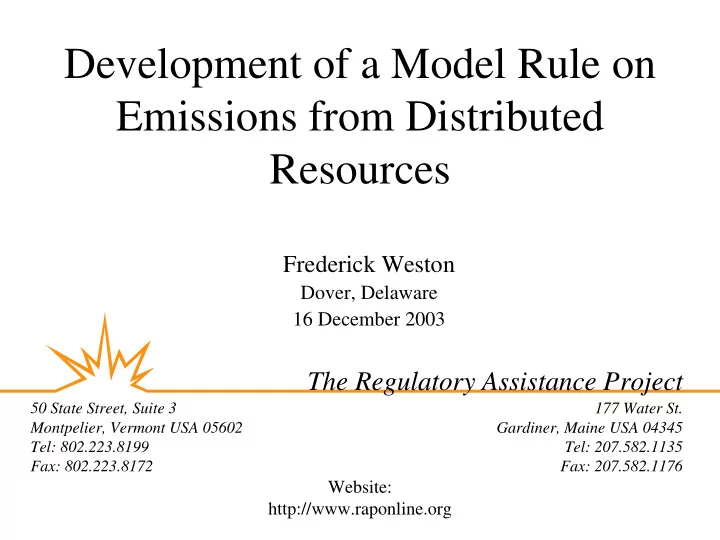

Development of a Model Rule on Emissions from Distributed Resources Frederick Weston Dover, Delaware 16 December 2003 The Regulatory Assistance Project 50 State Street, Suite 3 177 Water St. Montpelier, Vermont USA 05602 Gardiner, Maine USA 04345 Tel: 802.223.8199 Tel: 207.582.1135 Fax: 802.223.8172 Fax: 207.582.1176 Website: http://www.raponline.org
Purpose � Recognizing the role of DR in existing and restructured electricity markets � What concerns are being addressed? – Environmental protection with technology and industry changes – Promoting clean DR – Administrative simplicity – Promoting certification of small engine conformance to clean standards
Who? � A 30-member working group made up of state energy regulators, state and federal air quality regulators, manufacturers, interest groups (environmental and industry) � Work done primarily by conference call and e-mail; two face-to-face meetings � Agreement sought to the greatest extent possible
Timeline � Kick-off meeting in January 2001 – Issue areas (applicability, emissions, certification, credits for offsets) assigned to sub-groups � May 2001 meeting � November 2001 Public Review Draft � Revisions, February through August 2002 � Final draft, 31 October 2002
Principles Guiding Development of the Rule � The model emissions standards should: – Lead to improved air quality, or at least do no additional harm – Be technology-neutral and fuel-neutral, to the extent possible – Promote regulatory consistency across states • Reduced barriers � improved economic efficiency � greater environmental benefit
Principles Guiding Development of the Rule � The model emissions standards should: – Promote technological improvements in efficiency and emissions output • Encourage the use of non-emitting resources • Account for the benefits of CHP and the use of otherwise flared gases – Be easy to administer • Facilitate the development, siting, and efficient use of DR
Key Issues: Applicability � What types of sources should be covered? – New only � What sizes of engines should be addressed? – Anything not covered by federal NSR � What functions should be covered? – Emergency and non-emergency
Key Issues: Emissions � Establish “appropriate” emissions standards – Better than grid average, as good as new BACT for large combined cycle sources, LAER? • A middle ground that pushes technology to beat expected improvements over the next decade � Credits for flared fuels, CHP, renewables and end-use efficiency � Pollutants: NO X , PM, CO, CO 2 , SO 2
Proposed Emissions Limits � Emergency Generators – 300 hours annual operation – 50 hours annual maintenance (included in the 300 total) – EPA off-road engine standards, expressed in pounds/MWh
Proposed Emissions Limits � For NO X , PM, CO, CO 2 : – Output-based limits: pounds per MWh � For SO 2 : – Diesel is the issue – Ultra-low sulfur fuel requirement – Following EPA on-road requirements � Technology review prior to Phase Three
Proposed NO X Limits (lbs/MWh) Non-Emergency Generators Non-Attainment Attainment Phase I (2004) 0.6 4 Phase II (2008) 0.3 1.5 Phase III * (2012) 0.15 0.15 * Subject to Technology Review
Proposed PM Limits Non-Gas only (lbs/MWh) Non-Emergency, All Areas Phase One (2004) 0.7 Phase Two (2008) 0.07 Phase Three * (2012) 0.03 * Subject to Technology Review
Proposed CO Limits (lbs/MWh) Non-Emergency, All Areas Phase One (2004) 10.0 Phase Two (2008) 2.0 Phase Three * (2012) 1.0 * Subject to Technology Review
Proposed CO 2 Limits (lbs/MWh) Emergency and Non-Emergency, All Areas Phase One (2004) 1900 Phase Two (2008) 1900 Phase Three * (2012) 1650 * Subject to Technology Review
On-Going Activities � 2003 – 2004: – Provide technical assistance to states considering adoption of DR emissions standards and removal of regulatory barriers to DR
More on Distributed Resources � Model Regulations for the Output of Specified Air Emissions from Smaller-Scale Electric Generation Resources – Model Rule and Technical Support Documents ; RAP, 31 October 2003 � State Regulatory Policy and Distributed Resources: Accommodating Distributed Resources in Wholesale Markets ; F. Weston with C. Harrington, D. Moskovitz, W. Shirley, R. Cowart, and R. Sedano; T. Basso, NREL Technical Monitor, NREL TP-32497 � State Regulatory Policy and Distributed Resources: Distributed Resources and Electric System Reliability ; R. Cowart with C. Harrington, D. Moskovitz, W. Shirley, F. Weston, and R. Sedano; T. Basso, NREL Technical Monitor, NREL TP-32498 � State Regulatory Policy and Distributed Resources: Distributed Resource Distribution Credit Pilot Programs: Revealing the Value to Consumers and Vendors ; D. Moskovitz with C. Harrington, W. Shirley, R. Cowart, R. Sedano, and F. Weston; T. Basso, NREL Technical Monitor, NREL TP -32499 � State Regulatory Policy and Distributed Resources: Distribution System Cost and Methodologies for Distributed Generation ; W. Shirley with R. Cowart, R. Sedano, F. Weston, C. Harrington, and D. Moskovitz; T. Basso, NREL Technical Monitor, NREL TP-32500 � State Regulatory Policy and Distributed Resources: Distribution System Cost Methodologies for Distributed Generation Volume II Appendices ; W. Shirley with C. Harrington, D. Moskovitz, R. Cowart, R. Sedano, and F. Weston; T. Basso, NREL Technical Monitor, NREL TP-32501
Recommend
More recommend